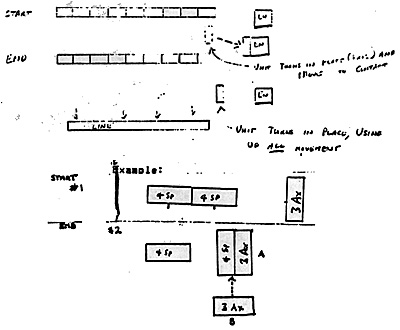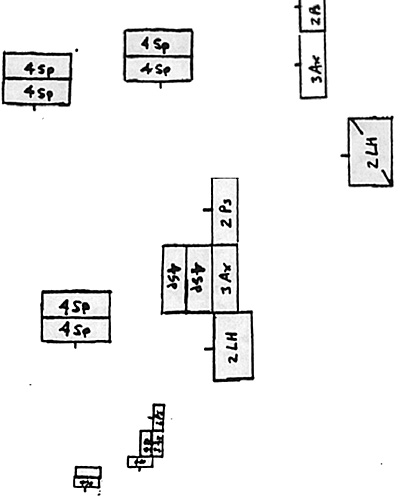I have greatly enjoyed playing DBA. I have had a degree of success in getting non-figure gamers to try them. I know one other player (Craig 'Buc' Fox) with a suitable pair of painted (15mm) armies. The small number of figures and short playing time make it an appealing set of rules for the beginner.
But, I have several rules questions, mostly about movement which I would appreciate an authoritative answer to. We went to a convention in Dallas (Texas: 650 miles from Albuquerqe) this fall, and I find at least one of their intrepretations STRANGE!
Most of those questions were in connection with our 15mm games; Buc has Camallian Romans, Gauls, and New Kingdom Egyptians. I have General Purpose Greeks (Later Hoplite, Syracusan, etc) Threcians, Assyrians and a bunch of Classical and Bronze age parts which we have used to cobble together some other armies. I'm working on Carthagininans and Spanish. OK? Many people are not clear on the concept of fielding historical opponents. When putting together a group order for figures last night, I had a guy looking for a Classical army with Blades and Pike: I told his he could do Swiss, but even he admitted that was out of the periods we have been playing in.
Many of our games have taken place on a clear space, 2' x 2'. When Gauls fight Camillian Romans, terrain is rather irrelevant! Since I have now fielded some of the Auxillia armies (Thracians and Early Hebrews), the question of terrain has now arrisen. We do not have any *Pre-made* terrain boards yet. Is there a minimum size for a "Bad Going" terrain?
I would suggest a place big enough to hold 2-3 elements (40 x 60) as a minimum size for a piece of Bad Going.
A technique one of the rules lawyers came up with when given terrain was to place was to place them in opposite corners of the boards, rendering the bad going practically useless except to protect a flank or the baggage camp!
First of all, I really haven't played DBA that much. I much prefer WRG 7th. But I did manage to beat Phil in my first ever game so there is a bit of notoriety involved here, I guess. Here's my best shot, here goes...
For Bad Going, I use 1/3 "regular" size WRG terrain pieces; i.e. instead of a 13" hill/woods/earsh, use a 4" one for DBA on a 2'x2' table. The best way to generate terrain, if not using pre-set boards, is the same as WRG 7th. You each get to pick 4 pieces, then roll for precedence and placement.
 The philosophy of the rules is to encourage players to keep their armies in a line of
elements. What I consider the "odd" interpretation from
Dallas was that an element could turn in place and
charge; see the attached highlighted extract from the
rules for the guilty sentence.
The philosophy of the rules is to encourage players to keep their armies in a line of
elements. What I consider the "odd" interpretation from
Dallas was that an element could turn in place and
charge; see the attached highlighted extract from the
rules for the guilty sentence.
I think the intent was that all turns are by wheeling, based partly on the philosophy in 7th Edition, etc. What I have been allowing is for elements to turn in place to face a now threat, but not to move to contact in the same bound.
Gaarsee Version:
Sorry, Karl, but the rules clearly state that a single element's move can include any number of wheels or turns of any angle (Pg. 7, Para. 8). Not realistic, but quick and easy.
Part of the problem is how you resolve attacks from flanks; The rules are quite clear about units turning to face. Does this mean even when you are clearly contacting a unit from the flank the element does NOT suffer a penalty?
The only way to 'flank' a unit is to hit it with two units. In the first illustration, the 4sp can turn to fight the 3Ax on contact. In illustration 2, 3Ax (unit 8) will count as an overlap on 4sp... this is the penalty.
 Problem 2
Problem 2
This came up in a Greek/Thracian game; I was trying to be a gentleman, and didn't hunt through the rules to find the sentence which says groups can NOT turn, but how should we have resolved this?
My opponent said the two elements of Spears could turn to face my Aux (Free) so it was even up (Because of the Flanking units); Needless to say, when confronted with the "Whirling Hoplites" and mediocre dice, I resigned the game as unwinable.
Karl, you're ending in contact with only the rearmost element certainly is legal ... and and smart. It prohibits your opponent from facing both 4SP elements to fight your 3AX unit (P9. 8, Para 5).
Problem #3 (Philistines vs Early Hebrews)
This involves the turning to face rule; Is the Blade unit considered to be in contact with the Chariot "A"? Chariot "A" destroyed its opponent. "B" was recoiled by the blades on the Hebrews Bound. (I think...I was an observer on this one).
In order to be 'in contact', units must be facing the enemy 'front' or flank (see Close Combat, Pg. 8, Para. 5). One of those elements would have to turn to face in order to engage in close combat.
Can a line of *lments back up? Our rules lawyer insists they turn (180 degree "About Face"), move their 200 paces, and turn around again.
A line of elements must first form a 1 element wide column "(moving) away from enemy to its front" (Pg. 7, Para. 7) before turning and moving straight back. No, you cannot turn back to face - and you'd be in a real bad situation unless LC/LCI
Can units other than Knights or Warbands follow up?
Only Knights, Warbands and Scythed Chariots must pursue "for 1 base length" except for elements "in contact with a camp whose defenders are destroyed, recoil or flee" - they'll capture the camp (Pg. 9, Para. 8)
Do you allow elements to move by inclining, and how great an angle?
Units cannot incline they may only wheel up to 90 degree (pg. 7, Para. 7).
Can Psiloi or Light Horse voluntarily flee 600 paces, or are they restricted to breaking off? Breaking off effects the turning rule, if you must spend a coaaand point to turn a unit in place, it is a much more serious matter to break off a unit.
Light troops can flee as per Pg. 7, Para. 7 - form column and run away! Remember, you can 'turn' and move a single element. If a unit, columns must be formed.
A couple of suggestions, setting up second seems to confer a key advantage on some armies, or maybe I am not very good at organizing my armies; Any possible modification: A deploys Eight Elements, B Deploys. A deploys the other Four. No more than three on either Flank zone?
How about a rule to put more bad going on the table for armies like the Thracians and Hebrews?
A suggested new type of Element: A *Mixed* Bow or Spear type for Assyrians, Persian, and English Longbow. It would function as either a Bow (as published) or a +3 Spear. type determined at the beggining of the owning players bound. Represent them as two of each kind of figure on the same element.
Back to Saga v5n6 Table of Contents
Back to Saga List of Issues
Back to MagWeb Master Magazine List
© Copyright 1991 by Terry Gore
This article appears in MagWeb.com (Magazine Web) on the Internet World Wide Web. Other articles from military history and related magazines are available at http://www.magweb.com